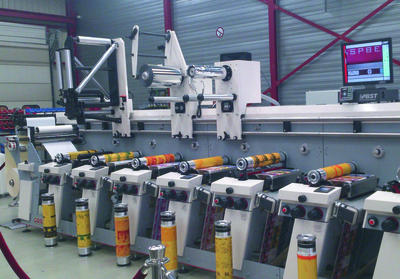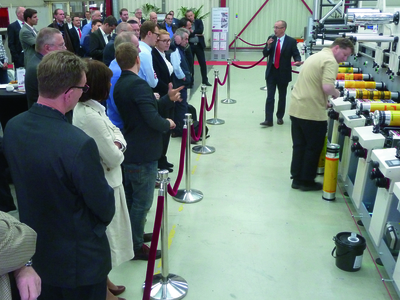New entrants to the label market may stay away from manufacturers at the upper end of the scale for fear of investing too much too soon. To make itself more accessible to those with smaller budgets, MPS opened the doors to its Didam headquarters, in the Netherlands, to show off its lowest priced press yet, the EB press. Michal Lodej reports.
The EB flexo press was first launched at Labelexpo last year as a prototype, but now the press is ready for installation and it was Eric Hoendervangers, commercial director and co-founder, who opened the three day event welcoming the visitors. He said, ‘MPS has a strong focus on helping customers to excel by understanding their challenges and needs, and bringing them the lowest cost of producing labels.’
The EB is the cheapest press that has ever been available from MPS and it is aimed both at companies starting out in label production and those that want to extend their label production with a cost-effective label press. It is designed for printing and converting self-adhesive labels and is available with a print width of 360 mm and a material width of 370 mm.
The EB in motion
The new machine has three main features which all help the operator to decrease the time it takes to change jobs and to cut down on waste. These features, iSet, Crisp.Dot Light and iStop, were the main focus of the demonstration during the open house event.
With Crisp.Dot Light, there is no gear connection between impression and plate cylinders. This means the gear profile has no influence on the pressure settings and so will not affect the consistency of the print quality.
Pressure control is configured using a set of knobs, which include a click function. This simple feature gives the operator another way by which to control the tension rather than just relying on sight. With iSet technology, not only the left and right pressure settings of the plate cylinder/anilox roller can be set, but also the parallel pressure settings.
During the live demonstration, the label design and repeat size were changed. This was done within five minutes before the press was up and running again. The printing cylinders have a lightweight design, which makes job changeovers easier. With iStop technology, the print cylinder and anilox roller will remain in print position while the press is stopped.
Therefore once the press has stopped, for example after a roll change, and re-starts, the print units resume printing without any waste.
The press on the day was using seven colours: CMYK, orange, green, purple plus a clear varnish.
When it comes to cleaning a print station, the doctor blades, anilox rollers and ink wells are all fitted with handles for easy removal.

The EB Press
With a configuration of up to 10 print stations, the EB press can also be equipped with a double die station suitable for front and reverse side die-cutting, sheeting and slitting.
Various converting applications, such as web turner bar, de-lam/relam, and laminating solutions including cold foil, can be implemented at any location along the press using its flexible positioning rail system. Additional features, such as crossover multi-layer labels, can also be added.
A range of drying options is available, including UV drying, IR combination drying and hot air drying.
These modules allow this entry level press to be upgraded as and when the customer requires, keeping it suitable for companies as they grow and take on more complex work.
The concept
When asked what the thought process was behind the press, Mr Hoendervangers explained, ‘We did a study of all the different aspects of printing which can affect the efficiency of a press room, and took into account every aspect of the press. What we found was that one of the most important factors in a production environment was operator motivation.
‘We can build anything, even a rocket to the moon, but if it doesn’t help the operators, their motivation and productivity will go down. When companies come to make a second investment, we want them to come back to us. That is why this press has been designed with so many userfriendly features.’
Keeping the press simple means it does not come with automatic registration control as standard, however, according to the company the press is so well built it does not need one, although it can be installed on request.
The EF press
Also on display at the open house was the EF multi-substrate press, a different machine aimed at a completely different level of the market. This is built on a non-operator intervention concept, aiming to help the operator by automating most processes to improve efficiency.
The EF is a short-web press available in a range of different widths, and comes with a sophisticated temperature control, which opens it up for use with heat-sensitive substrates.
The company describes the press as having offset matching quality, which it says it achieves by separating the printing from the web transportation system. This gives the press better tension control, which is key for the high quality it can achieve.
All data programmed into the press is stored in a memory bank for repeat jobs. During the demonstration, it took just 23 metres to complete set up and registration, emphasising its low wastage. Changing the design repeat size and substrate took just a matter of minutes.
The company is focusing on time saving as it claims that by saving just 10 minutes per job will allow time for an extra 400 jobs per year.
It is clear that MPS has done its market research carefully with the launch of the EB press, making it better suited for short run work and designed to make the operator as happy as possible. By making it the lowest priced press produced by the company, it is opening up the brand to a new level of the market.
The three-day event was a great success with over 120 existing and potential customers, partners, suppliers and press from Europe, South Africa, India, Pakistan, Turkey and Zimbabwe, attending.
Mr Hoendervangers said, ‘We appreciate the number of visitors who took time to attend our open house last week. It gave us the opportunity to showcase our new EB and EF flexo press technologies and share our industry knowledge and capabilities with leading label printers. Our manufacturing floor was buzzing with conversations after each session, and feedback from visitors has been overwhelmingly positive. It was an overall success for everyone involved.’






